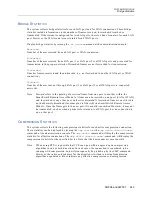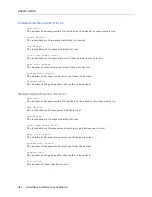
USER’S GUIDE
232 SmartSwitch Remote Access Module
TFTP C
OMMANDS
The TFTP feature and its commands are only available when IP routing is enabled. The TFTP
feature and file access are enabled by default when the system software is installed. The following
TFTP commands are available:
tftp get
Allows you to perform the “TFTP GET” operation locally from the console through the TFTP
Client function. The following is an example display of a TFTP GET screen.
tftp kill <session Id>
Allows you to kill a TFTP session. The session Id must be included in this command. To obtain
the session Id, issue the
tftp session
command which displays the TFTP session
information.
tftp put
Allows you to perform the TFTP PUT operation locally from the console through the TFTP
Client function. The following is an example display of a TFTP PUT screen.
tftp session
Displays the TFTP session information of active TFTP sessions. To get detailed information on
a specific session, enter the session’s Id number when prompted. You can not display the
> TFTP GET
>IP Address of the Host containing the file
(<RET> to abort)? 19.233.45.33
>Enter the name of the local file to write (including the full path)?
(<RET> to abort)? \config\config.nei
>Enter the name of the remote file (including the full path)
(<RET> for same as local)? <RET>
Enter the mode (BIN [binary] or ASC [ascii])
<RET> for ascii? bin
Receiving File... Please wait
File Transfer Complete...
> TFTP PUT
>IP Address of the Host to receive the file
(<RET> to abort)? 19.233.45.33
>Enter the name of the local file to send (including the full path)
(<RET> to abort)? \config\config.nei
>Enter the name for the remote file (including the full path)
(<RET> for same as local)? <RET>
Enter the mode (BIN [binary] or ASC [ascii])
<RET> for ascii? bin
Sending File... Please wait
File Transfer Complete...






























